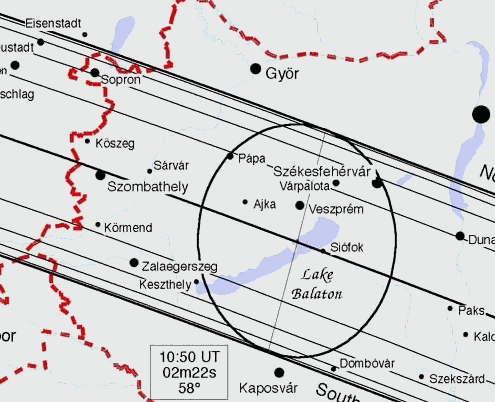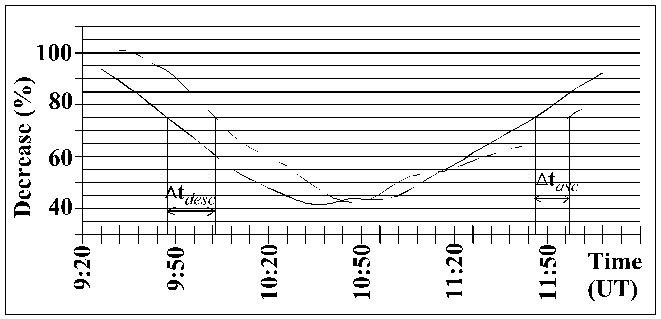
T. Medovarszki, Debrecen University, Debrecen, Hungary,
medtamas @freemail.hu
P. Bencze, Geodetic and Geophysical Research Institute, Sopron, Hungary,
bencze @ggki.hu
A. Ludmány, Heliophysical Observatory, Debrecen, Hungary,
ludmany @tigris.klte.hu
Abstract
The 1999 eclipse provided a unique opportunity to study the delay
of the ionospheric response to the changes of the solar ionizing radiation.
Previous eclipse experiments were based on the assumption that the solar
disc was a uniform source of the ionizing radiation. In the recent era
of the space observations this assumption is obsolete. In the present work
the temporal runs of the solar high energy radiation intensities have been
computed on the basis of space observations and they have been compared
with the electron density measurements of the ionospheric E-region carried
out by the ionosonde at Sopron, Hungary, which was crossed by the totality
zone. The delays between radiation and electron concentration in the decreasing
as well as increasing parts of the curves contain informations about the
dynamics of recombination and ionization processes.
INTRODUCTION
The total solar eclipses offer extraordinary
opportunities to study dynamical processes of the terrestrial atmosphere
(Boitman et al. 1999; Liu et al. 1999; Tsai and Liu, 1999; Afraimovich
et al. 2000). Among the most spectacular processes parallel to the eclipse
are the decrease and increase of the ionospheric electron density. Of course,
this parameter has a diurnal variation but the ionising solar radiation
disappears in the evening and re-appears in the morning so smoothly and
gradually that the ionospheric response gets smeared, it is difficult to
recognize its genuine nature. However, the temporal proceeding of the coverage
of radiating surface is much better defined during a total solar eclipse.
By using this consideration there were previous
attempts to study the atmospheric effects of the total eclipse. These earlier
studies were based on the assumption that the solar radiation intensity
is equally distributed over the surface of the solar disc like that in
the visible wavelength domain. However, in the era of the space observatories
it became clear that this is a fairly naive an unappropriate assumption
in the domain of high energy radiation which is responsible for the ionisation
of the atmosphere. The shorter is the wavelength the more intermittent
its distribution. In the far ultraviolet and X-ray domains the volumes
above the active regions are bright and those above quiet regions are faint
or dark.
For this reason it appears appropriate to
assume that the uneven distribution of high energy intensity on the solar
disc may result in a specific fine structure of the temporal run of the
integrated solar intensity in the given wavelength domain. Furthermore,
if such a fine structure could be related to the occasional fine structure
in the temporal run of the ionospheric electron density, then the characteristic
time of the ionospheric response could be determined more precisely and
the dynamics of the ionization/recombination processes could be studied
on a much finer timescale.
OBSERVATIONAL MATERIAL AND PROCEDURE
For the above purpose the SOHO/EIT 304A,
171A and 195A (Delaboudini?re et al., 1995) and Yohkoh SXT observations
(Tsuneta et al., 1991) are the most suitable, because these instruments
provide full-disc images at short wavelengths (no full disc TRACE mosaic
was available for the given moment). The ionospheric impact was monitored
by the ionosonde of the Geodetic and Geophysical Research Institute at
Sopron (Fig.1.) which, by chance, was crossed by the totality zone.
The ideal case would be if full disc observations
were available in those wavelengths which are considered to be most effective
in ionizing the atmosphere (for instance Lyman-beta). However, the list
of observed wavelengths is given by the programs of the spaceborn instruments
so the high energy distributions should be represented by existing full
disc images of the observed wavelengths. Observations closest in time to
the maximum phase at Sopron (10:47 UT) were selected for the above mentioned
wavelengths.

Figure 1. Map of the Western region of Hungary affected by the total solar eclipse. The location of the ionosonde is indicated by an arrow.
A simulation program has been adopted to these images to obtain the temporal runs of the intensities in the region of the ionosonde. An artificial lunar disc has been progressively shifted by one minute steps along the solar disc and the intensities of the uncovered pixels have been summed up (i.e. the uncovered surface intensity has been integrated) at each step.
RESULTS AND DISCUSSION
As a result, two curves can be compared,
those of the electron density of the ionospheric E-layer measured by the
Sopron ionosonde and the integrated solar high-energy flux measured by
the Yohkoh SXT (we represent here by this latter one the high energy flux
in general). The scaling of the curves may be arbitrary for the sake of
easier comparison. The direct data of the ionosonde are plasma frequencies
which can be converted to electron densities, whereas the intensity data
of the solar image (those of the image pixels) were only taken into account
in the common 8-bit units, because in the present context only the temporal
run is relevant but not the absolute intensities. The scaling of the two
curves were so transformed that both their stationary (out of eclipse)
and minimum values match with each other, furthermore, the ionosonde curve
has been smoothed with a 5-point sliding mean (Figure 2.).
A somewhat disappointing feature of the solar
intensity curve is that it does not exhibit the fine structure which might
have been expected on account of the highly inhomogeneous intensity distribution,
and not only the SXT-curve, the UV-curves of EIT are even smoother. However,
these smooth curves are also suitable to study the response because of
the above mentioned arbitrary scaling. We considered the delays of the
ionospheric values from the corresponding solar intensity values.
It is remarkable that the delay of the ionospheric
curve on the descending wing is longer than that on the ascending one.
This is no surprise, they are resulted by different mechanisms, the former
is related to the rate of the recombination processes whereas the latter
one is related to the ionization rate.

Figure 2. Temporal runs of the solar SXT (Yohkoh) integrated intensity (thick line) as well as the electron density of the ionospheric E-layer in the region of Sopron, Hungary (thin line).
To determine the above delay times, two arbitrary
depression values have been chosen about the middle of the wings, namely
at 70% and 75%,. Fig.2. indicates the relevant ![]() and
and ![]() delays for the 75%
depressions. For these two values the delay times were 14.2 min and 15.6
min on the descending phase as well as 11.3 min and 11 min on the ascending
phase respectively. This means that the characteristic times of the ionospheric
responses are: 15min for the recombination processes and 11min for the
ionization processes with a precision of about a half minute.
delays for the 75%
depressions. For these two values the delay times were 14.2 min and 15.6
min on the descending phase as well as 11.3 min and 11 min on the ascending
phase respectively. This means that the characteristic times of the ionospheric
responses are: 15min for the recombination processes and 11min for the
ionization processes with a precision of about a half minute.
These delay times will provide a tool for
a further analysis of the effective cross sections of ionospheric processes.
Details of a possible interpretation will be discussed elsewhere.
ACKNOWLEDGEMENTS
Two authors (T. Medovarszki and A. Ludmány) express their high appreciation
for the heartly welcome and accomodation support by the Hurbanovo Observatory.
The work was also supported by the Hungarian Science Foundation OTKA T025640.
REFERENCES
Afraimovich EL, Palamartchouk KS, Perevalova NP, Chernukhov VV, Lukhnev
AV, Zalutsky VT, 2000, Ionospheric effects
of the solar eclipse of March 9, 1997, as
deduced from data from the GPS-radio interferometer at Irkutsk, Adv Space
Res. 26: (6) 997.
Boitman ON, Kalikhman AD, Tashchilin AV, 1999, The midlatitude ionosphere
during the total solar eclipse of March 9,
1997, JGR-Space 104 (A12) 28197.
Delaboudini?re, J.-P.; Artzner, G. E.; Brunaud, J.; Gabriel, A. H.;
Hochedez, J. F.; Millier, F.; Song, X. Y.; Au, B.; Dere, K.
P.; Howard, R. A.; Kreplin, R.; Michels, D.
J.; Moses, J. D.; Defise, J. M.; Jamar, C.; Rochus, P.; Chauvineau, J.
P.;
Marioge, J. P.; Catura, R. C.; Lemen, J. R.;
Shing, L.; Stern, R. A.; Gurman, J. B.; Neupert, W. M.; Maucherat, A.;
Clette, F.; Cugnon, P.; van Dessel, E. L.
1995, EIT: Extreme-Ultraviolet Imaging Telescope for the SOHO Mission,
Solar
Phys. 162, 291.
Liu JY, Tsai HF, Tsai LC, Chen MQ, 1999, Ionospheric total electron
content observed during the 24 October 1995 solar
eclipse, Adv.Space Res. 24 (11) 1495.
Tsai H.F., Liu J.Y., 1999, Ionospheric total electron content response
to solar eclipses, JGR-Space, 104, 12657.
Tsuneta, S.; Acton, L.; Bruner, M.; Lemen, J.; Brown, W.; Caravalho,
R.; Catura, R.; Freeland, S.; Jurcevich, B.; Owens, J.
1991, The soft X-ray telescope for the SOLAR-A
mission, Solar Phys. 136, 37.